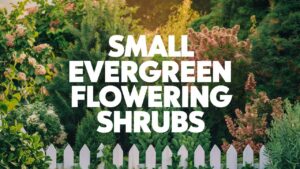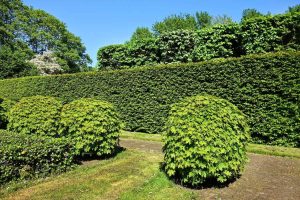As the weather warms and we spend more time outside, it’s the perfect opportunity to liven up our outdoor spaces with beautiful and vibrant plants. In this blog post, we’ll explore four fantastic options that thrive in the great outdoors.
Coneflowers
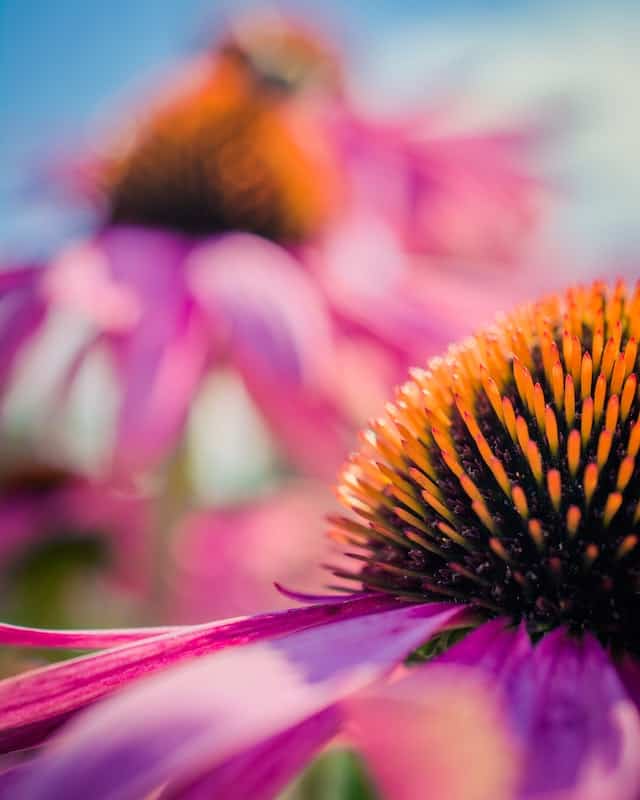
Coneflowers, also known as Echinacea, are a beloved perennial that add a burst of color to any garden or landscape. Native to North America, these hardy plants are easy to grow and require minimal maintenance. Their large, daisy-like flowers come in a range of hues, including pink, purple, white, and yellow, making them a versatile choice for mixing and matching.
Coneflowers are not only visually stunning, but they also have impressive ecological benefits. They attract a variety of pollinators, such as bees, butterflies, and hummingbirds, providing an important food source for these vital creatures. Additionally, the plants’ seed heads offer a winter food source for birds, making them a valuable addition to wildlife-friendly gardens.
When it comes to growing coneflowers, they prefer full sun and well-drained soil. They are drought-tolerant once established, making them a low-maintenance option for busy gardeners. To maintain their vibrant appearance, deadhead spent blooms regularly, and consider dividing the plants every few years to encourage new growth.
Mandevillas

Mandevillas are tropical vines that bring a touch of the exotic to outdoor spaces. With their large, trumpet-shaped flowers and lush foliage, these plants create a stunning focal point in gardens, patios, or even as container plants on balconies.
Native to South America, mandevillas thrive in warm, sunny conditions and can tolerate a range of soil types, making them a versatile choice for many climates. They come in a variety of colors, including pink, red, white, and yellow, allowing you to choose the perfect hue to complement your outdoor decor.
One of the key benefits of mandevillas is their long blooming season, which can last from spring through fall, depending on your local climate. To encourage continuous flowering, deadhead spent blooms and provide regular fertilization. These vines also require support, such as a trellis or obelisk, to climb and showcase their beautiful blooms.
Petunias
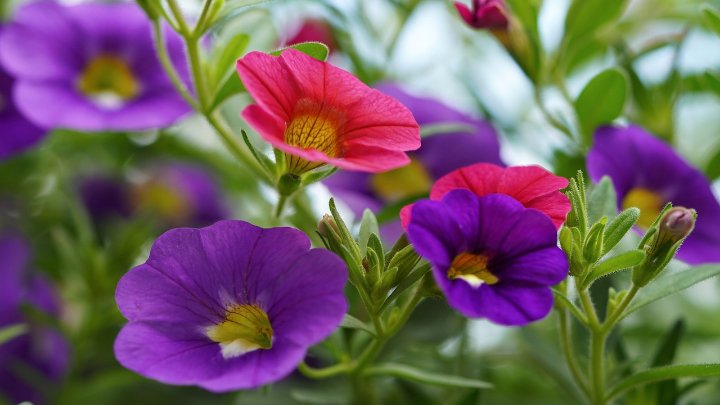
Petunias are a classic choice for adding vibrant color and cascading beauty to outdoor spaces. These versatile annuals come in a wide range of shapes, sizes, and color combinations, from the delicate, trailing varieties to the bold, mounding types.
Petunias thrive in full sun and well-drained soil, making them an excellent option for container gardens, hanging baskets, or as bedding plants in flower beds. They are relatively low-maintenance, requiring regular deadheading to encourage continuous blooming throughout the growing season.
One of the standout features of petunias is their ability to tolerate a range of environmental conditions, including heat, drought, and even light frost. This makes them a reliable choice for gardeners who want to add a pop of color to their outdoor spaces without the worry of high-maintenance plants.
Lavender
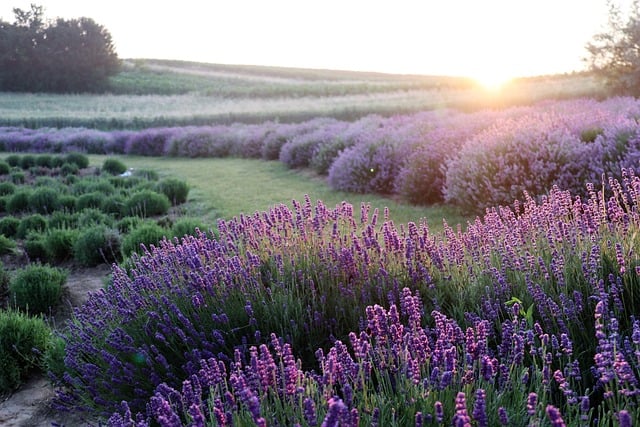
Lavender is a fragrant, drought-tolerant perennial that is a must-have for any outdoor garden or landscape. Native to the Mediterranean region, this aromatic plant is known for its calming scent and its ability to attract pollinators, such as bees and butterflies.
Lavender thrives in full sun and well-drained soil, making it an excellent choice for hot, dry climates. Its silvery-green foliage and purple, spike-like flowers create a visually stunning display that complements a wide range of garden styles, from formal to cottage-inspired.
Beyond its aesthetic appeal, lavender is also prized for its practical uses. The dried flowers can be used in sachets, potpourri, and even culinary applications, adding a delicate flavor to various dishes. Lavender’s calming properties also make it a popular choice for creating relaxing outdoor spaces, such as meditation gardens or seating areas.
To maintain the health and appearance of your lavender plants, be sure to provide them with well-draining soil, regular deadheading, and occasional pruning to encourage bushy growth and prevent the plants from becoming leggy.
Succulents
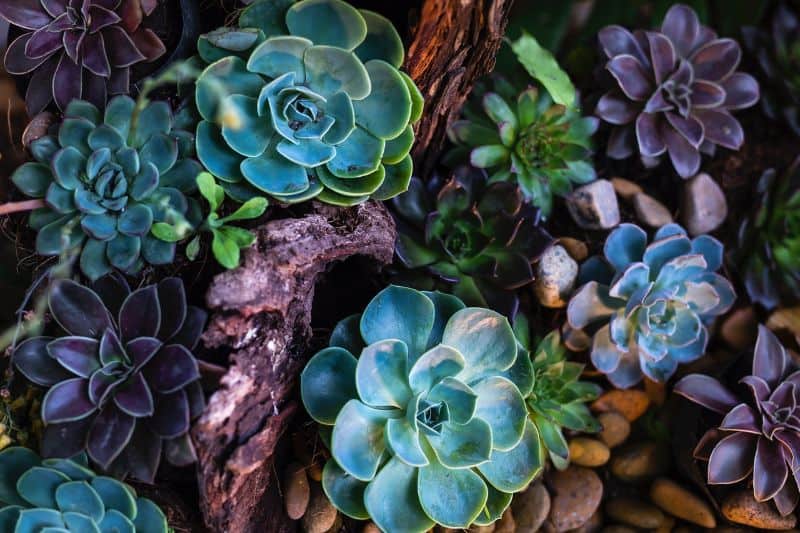
Succulents have become increasingly popular in recent years, and for good reason. These hardy, low-maintenance plants are the perfect choice for adding a touch of modern, drought-tolerant flair to any outdoor space. From the iconic rosette shapes of echeveria to the cascading tendrils of trailing sedums, succulents come in a wide variety of shapes, sizes, and colors that can be used to create visually stunning displays.
One of the key benefits of growing succulents outdoors is their ability to thrive in hot, dry conditions. These plants are native to arid regions and have evolved to store water in their thick, fleshy leaves and stems, making them incredibly resilient to periods of drought. This makes them an excellent choice for gardeners who live in warm, sunny climates or those who have limited time for watering.
When it comes to planting succulents, they prefer well-draining soil and full sun exposure. They can be grown in a variety of containers, from traditional pots to creative repurposed items, and can even be used as ground cover in rock gardens or xeriscaping projects. To maintain their health and appearance, be sure to provide them with occasional watering and protect them from frost during the colder months.
Snapdragons
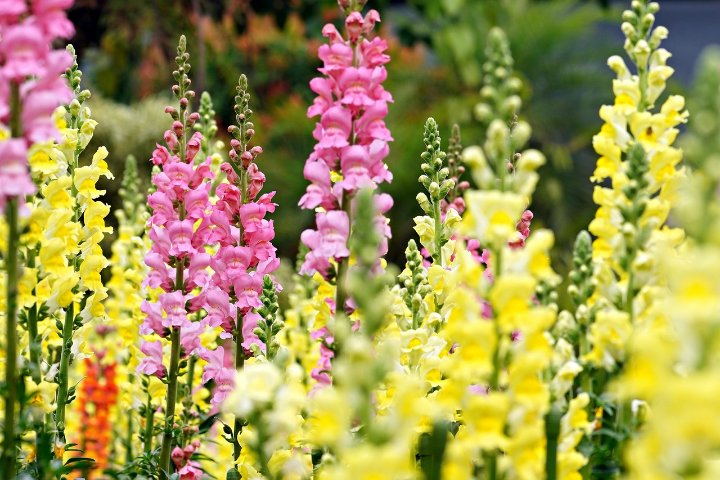
Snapdragons are a classic, old-fashioned flower that have made a comeback in recent years, and it’s easy to see why. These charming, whimsical plants are known for their unique, dragon-like flowers that come in a wide range of vibrant colors, from bold reds and yellows to delicate pastels.
Snapdragons are versatile plants that can be used in a variety of outdoor settings, from formal flower beds to casual cottage gardens. They thrive in full sun and well-drained soil, and their tall, upright growth habit makes them an excellent choice for adding height and structure to your garden.
One of the best things about snapdragons is their long blooming season, which can last from spring through fall, depending on your local climate. To encourage continuous flowering, be sure to deadhead spent blooms regularly and provide them with a balanced fertilizer every few weeks.
Lantana
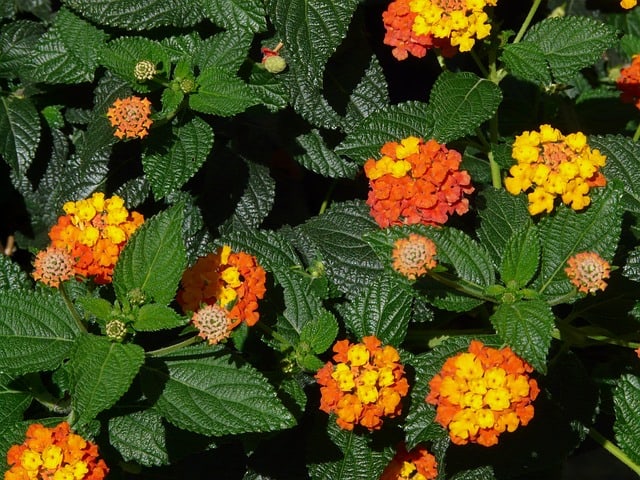
Lantana is a vibrant, heat-loving plant that is a true standout in any outdoor space. With its clusters of brightly colored flowers that bloom from spring through fall, lantana adds a tropical flair to gardens, patios, and even container plantings.
These plants are native to the Americas and are known for their ability to attract a variety of pollinators, including butterflies, hummingbirds, and bees. This makes them an excellent choice for gardeners who want to create a wildlife-friendly oasis.
Lantana thrives in full sun and well-drained soil, and it is relatively drought-tolerant once established. To maintain its lush, bushy appearance, be sure to deadhead spent blooms regularly and provide it with a balanced fertilizer every few weeks.
Cherry Tomatoes
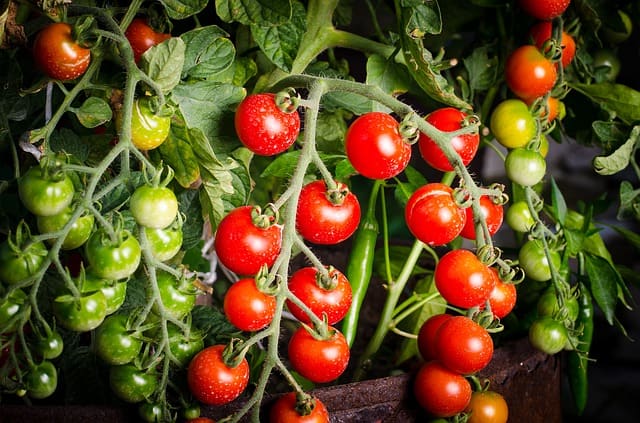
While not a traditional “ornamental” plant, cherry tomatoes are a must-have for any outdoor garden or patio. These compact, prolific plants are perfect for adding a touch of edible beauty to your outdoor space, and they can be grown in a variety of containers, from hanging baskets to raised beds.
Cherry tomatoes come in a wide range of colors, from the classic red to more unique hues like yellow, orange, and even purple. They are known for their sweet, flavorful fruit, which can be enjoyed fresh, in salads, or even used in homemade sauces and salsas.
When it comes to growing cherry tomatoes, they prefer full sun and well-drained soil. Be sure to provide them with a sturdy support system, such as a trellis or cage, to help them grow upright and prevent the fruit from touching the ground. Regular watering and the occasional application of a balanced fertilizer will also help ensure a bountiful harvest.
Basil
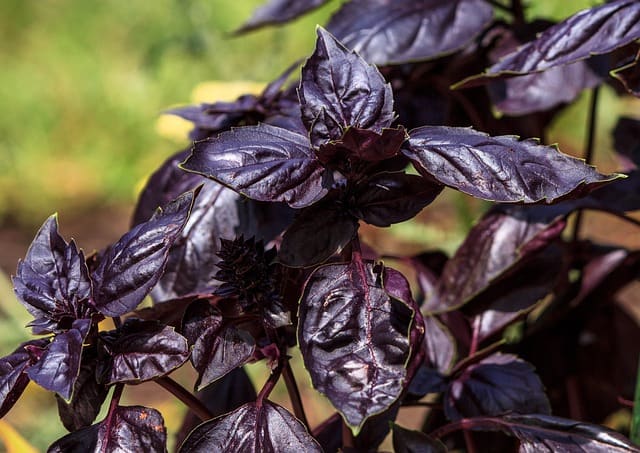
Basil is a beloved herb that not only adds a delicious flavor to our favorite dishes but also makes a beautiful addition to any outdoor garden or container. This fragrant, bushy plant is a true multitasker, providing both culinary and ornamental value to your outdoor space.
When it comes to growing basil, it thrives in full sun and well-drained soil. It’s important to keep the soil consistently moist, as basil doesn’t tolerate drought well. To encourage a bountiful harvest, be sure to pinch off the flower buds as they appear, which will redirect the plant’s energy into producing more flavorful leaves.
Beyond its culinary uses, basil also makes a stunning ornamental plant. Its vibrant green leaves and delicate white or purple flowers create a beautiful contrast in garden beds or patio containers. Plus, the plant’s strong, peppery aroma can help deter pests, making it a valuable companion plant for other vegetables and herbs.
Whether you’re growing basil for its delicious leaves or its visual appeal, this versatile herb is a must-have for any outdoor gardener.
Annual Geraniums
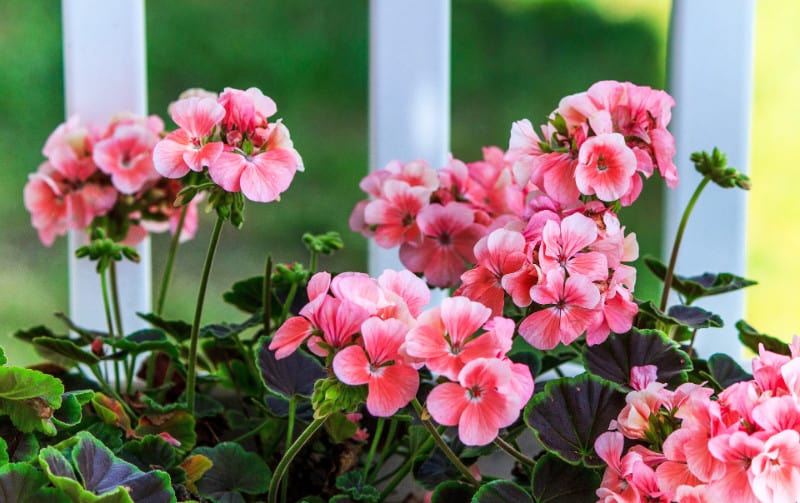
Annual geraniums, also known as zonal geraniums, are a classic choice for adding a burst of color to outdoor spaces. These resilient plants come in a wide range of hues, from the bold, fiery reds to the delicate, pastel pinks, making them a versatile option for any garden or patio.
One of the key benefits of annual geraniums is their ability to thrive in a variety of conditions. They prefer full sun but can also tolerate partial shade, and they are relatively drought-tolerant once established. This makes them an excellent choice for gardeners who want to add a splash of color without the hassle of high-maintenance plants.
To keep your annual geraniums looking their best, be sure to deadhead spent blooms regularly and provide them with a balanced fertilizer every few weeks. You can also consider pinching back the plants to encourage a more compact, bushy growth habit.
Whether you choose to plant them in garden beds, hanging baskets, or container gardens, annual geraniums are sure to add a touch of vibrant, eye-catching beauty to your outdoor space.
Anise Hyssop
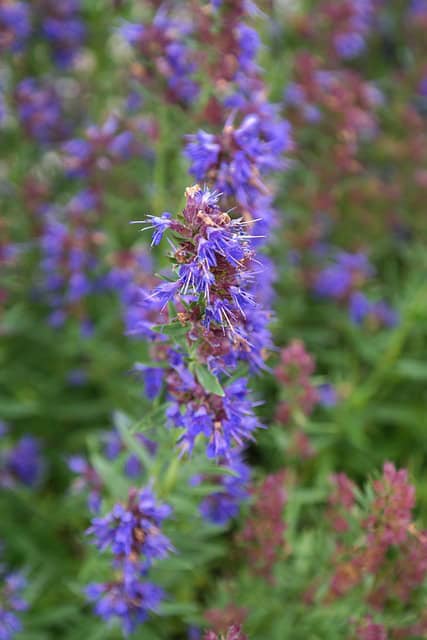
Anise hyssop, also known as licorice mint, is a fragrant, nectar-rich perennial that is a must-have for any pollinator-friendly garden. This plant’s distinctive licorice-like aroma and its striking purple flower spikes make it a standout in any outdoor setting.
Native to North America, anise hyssop is a hardy, drought-tolerant plant that thrives in full sun and well-drained soil. It’s an excellent choice for creating a low-maintenance, naturalistic garden, as it self-sows readily and can spread to form large, impressive colonies.
Beyond its visual appeal, anise hyssop is also a valuable resource for pollinators, such as bees, butterflies, and hummingbirds. Its nectar-rich flowers provide an important food source for these vital creatures, making it a crucial component of any wildlife-friendly garden.
To maintain the health and appearance of your anise hyssop plants, be sure to deadhead spent flower spikes regularly and provide them with occasional watering during periods of drought. With its unique fragrance, vibrant blooms, and ecological benefits, this plant is a true gem for any outdoor space.
Bee Balm
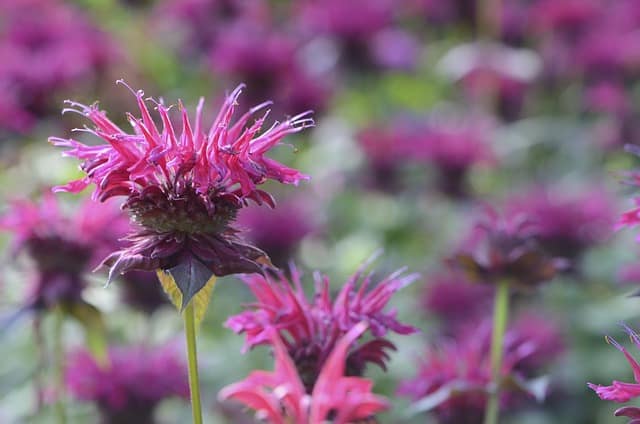
Bee balm, also known as monarda, is a vibrant, nectar-rich perennial that is a must-have for any pollinator-friendly garden. With its showy, pom-pom-like flowers and its distinctive, minty aroma, this plant is a true showstopper in any outdoor setting.
Native to North America, bee balm thrives in full sun and well-drained soil. It’s an excellent choice for creating a low-maintenance, naturalistic garden, as it self-sows readily and can spread to form large, impressive colonies.
Beyond its visual appeal, bee balm is also a valuable resource for pollinators, such as bees, butterflies, and hummingbirds. Its nectar-rich flowers provide an important food source for these vital creatures, making it a crucial component of any wildlife-friendly garden.
To maintain the health and appearance of your bee balm plants, be sure to deadhead spent flower heads regularly and provide them with occasional watering during periods of drought.
Nasturtium
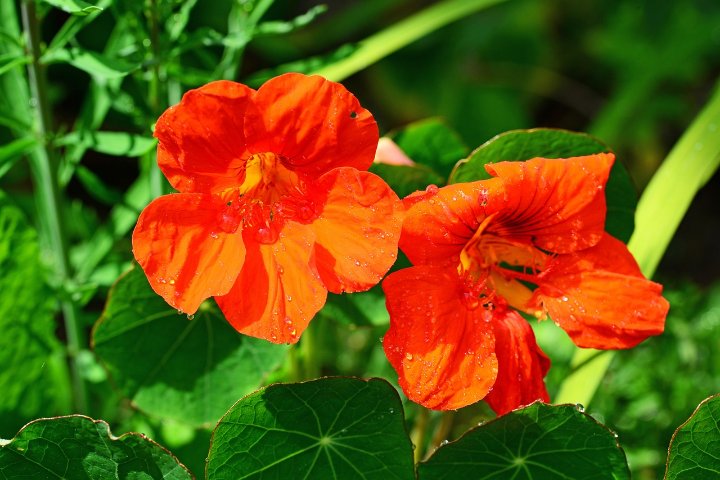
Nasturtiums are a vibrant, trailing plant that add a burst of color and whimsy to any outdoor space. With their distinctive, rounded leaves and brightly hued, edible flowers, these plants are a true delight for the senses.
One of the standout features of nasturtiums is their versatility. They can be grown as trailing vines, cascading from hanging baskets or spilling over the edges of raised beds, or as compact, mounding plants in garden beds. Their flowers come in a range of warm, earthy tones, including shades of yellow, orange, red, and even deep purple.
Beyond their visual appeal, nasturtiums are also prized for their culinary uses. The peppery-flavored flowers and leaves can be used to add a unique twist to salads, sandwiches, and even as a garnish for various dishes. They are also known to have some medicinal properties, with the leaves and flowers being used to treat minor skin irritations and respiratory issues.
When it comes to growing nasturtiums, they prefer full sun and well-drained soil. They are relatively drought-tolerant and can even thrive in poor soil conditions, making them an excellent choice for gardeners with challenging growing environments. To encourage continuous blooming, be sure to deadhead spent flowers regularly and provide them with a balanced fertilizer every few weeks.
Roses

Roses are a classic choice for adding timeless beauty and fragrance to any outdoor space. These iconic flowers come in a wide range of shapes, sizes, and colors, from the delicate, tea roses to the bold, hybrid teas, making them a versatile option for gardens, patios, and even containers.
One of the key benefits of growing roses is their ability to create a stunning, romantic ambiance in any outdoor setting. Their lush, velvety petals and captivating scents can transform a simple garden into a true oasis of beauty and tranquility.
When it comes to caring for roses, they do require a bit more attention than some other plants. They prefer full sun and well-drained soil, and they benefit from regular pruning, deadheading, and the application of a balanced fertilizer. However, with the right care and attention, roses can thrive for many years, providing you with a bountiful harvest of stunning blooms.
Whether you choose to grow climbing roses, shrub roses, or even miniature roses, these timeless plants are sure to add a touch of elegance and charm to your outdoor spaces.
Cleome
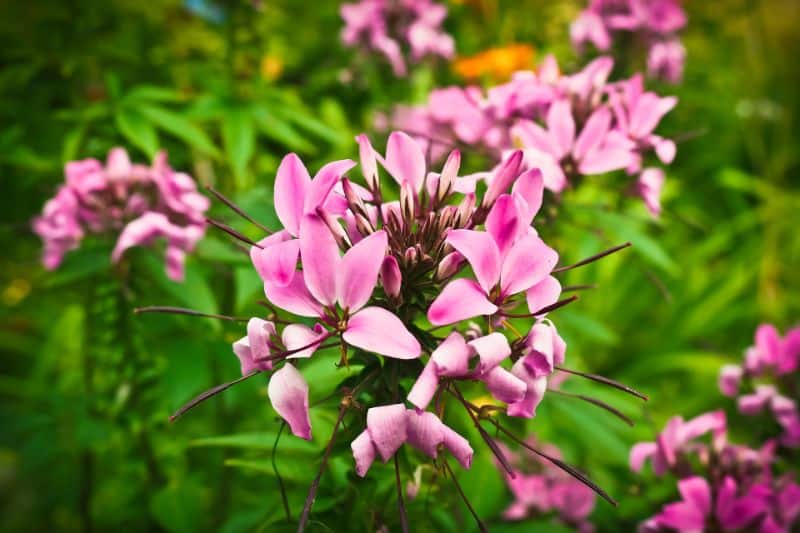
Cleome, also known as spider flower, is a bold and unique annual that adds a touch of whimsy and drama to any outdoor garden. With its tall, spindly stems and distinctive, spider-like flowers, this plant is sure to turn heads and capture the attention of passersby.
Cleome thrives in full sun and well-drained soil, making it an excellent choice for hot, dry climates. Its flowers come in a range of vibrant hues, including pink, purple, white, and even yellow, allowing you to choose the perfect shade to complement your garden’s color scheme.
One of the standout features of cleome is its ability to self-sow, meaning that it will readily reseed itself, providing you with a continuous display of blooms year after year. This makes it a low-maintenance option for gardeners who want to add a touch of carefree beauty to their outdoor spaces.
To maintain the health and appearance of your cleome plants, be sure to provide them with regular watering, especially during periods of drought, and consider staking the tall stems to prevent them from flopping over. With its unique, eye-catching flowers and its easy-care nature, cleome is a must-have for any outdoor garden.
Hibiscus
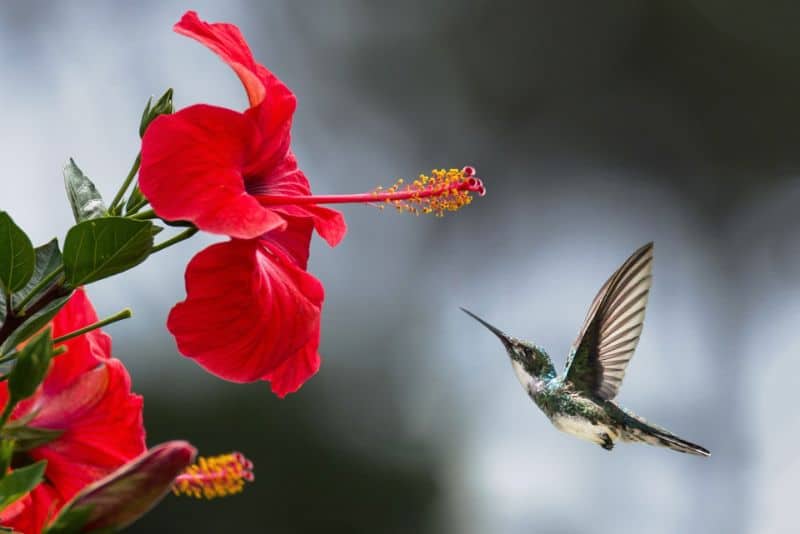
Hibiscus is a tropical, flowering plant that adds a bold, exotic flair to any outdoor space. With its large, showy blooms and lush, green foliage, this plant is a true showstopper, creating a stunning focal point in gardens, patios, or even as a container plant.
Hibiscus thrives in full sun and well-drained soil, making it an excellent choice for warm, sunny climates. Its flowers come in a range of vibrant hues, including red, pink, yellow, and white, allowing you to choose the perfect shade to complement your outdoor decor.
One of the key benefits of growing hibiscus is its long blooming season, which can last from spring through fall, depending on your local climate. To encourage continuous
Coleus
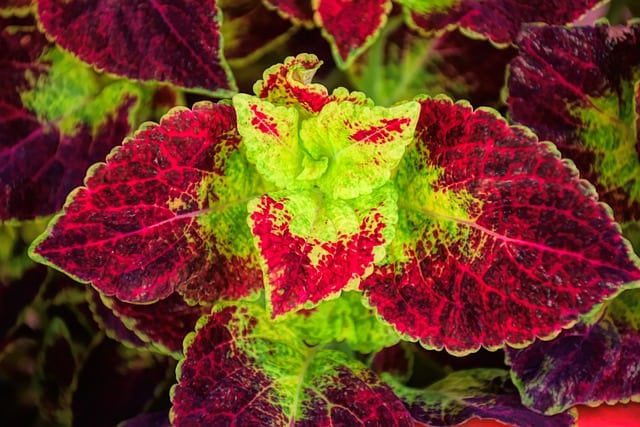
Coleus is a versatile, foliage-focused plant that adds a bold, vibrant touch to any outdoor space. With its wide range of leaf colors and patterns, from deep burgundy to neon green, this plant is a true chameleon, able to seamlessly blend into or stand out in a variety of garden settings.
One of the standout features of coleus is its ability to thrive in both full sun and partial shade. This makes it an excellent choice for gardeners who have a mix of light conditions in their outdoor areas. In full sun, the leaves tend to develop more intense, saturated colors, while in partial shade, the foliage often takes on a more muted, jewel-toned appearance.
When it comes to growing coleus, it prefers well-drained soil and regular watering, especially during hot, dry spells. To maintain its compact, bushy growth habit, be sure to pinch back the tips of the stems regularly, which will encourage the plant to branch out and become more full and lush.
Whether you choose to plant coleus in garden beds, containers, or even as a groundcover, its vibrant, eye-catching foliage is sure to add a touch of drama and interest to your outdoor spaces.
Begonias

Begonias are a versatile, low-maintenance plant that can add a pop of color and texture to any outdoor setting. With their wide range of foliage shapes, sizes, and hues, as well as their delicate, often-showy blooms, begonias are a true standout in the garden.
One of the key benefits of growing begonias is their ability to thrive in partial shade, making them an excellent choice for gardeners with areas that receive limited direct sunlight. They come in a variety of types, from the bold, waxy-leaved tuberous begonias to the delicate, trailing varieties, allowing you to choose the perfect plant for your specific needs and aesthetic.
When it comes to caring for begonias, they prefer well-drained, nutrient-rich soil and regular watering, especially during hot, dry periods. To encourage continuous blooming, be sure to deadhead spent flowers and provide them with a balanced, water-soluble fertilizer every few weeks.
Whether you choose to grow begonias in garden beds, hanging baskets, or container plantings, their vibrant colors and unique textures are sure to add a touch of elegance and charm to your outdoor spaces.
Ornamental Peppers
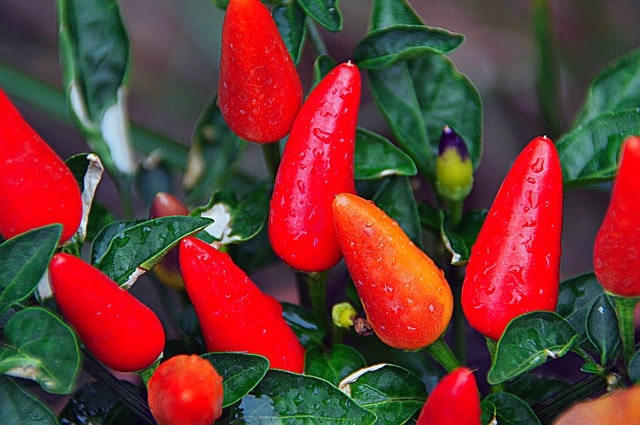
Ornamental peppers are a unique and eye-catching addition to any outdoor garden or patio. These plants not only offer a burst of color with their vibrant, jewel-toned fruits, but they also have the added benefit of being edible, making them a practical and versatile choice for gardeners.
Ornamental peppers come in a wide range of shapes, sizes, and colors, from the small, round “Explosive Ember” variety to the long, slender “Black Pearl” type. Their foliage can also be quite striking, with some varieties featuring deep purple or variegated leaves that add an extra layer of visual interest.
When it comes to growing ornamental peppers, they prefer full sun and well-drained soil. They are relatively drought-tolerant once established, but they will benefit from regular watering, especially during hot, dry spells. To maintain their compact, bushy growth habit, consider pinching back the tips of the stems periodically.
Whether you choose to use ornamental peppers as a focal point in your garden, incorporate them into container plantings, or even harvest their flavorful fruits for culinary use, these unique plants are sure to add a touch of whimsy and versatility to your outdoor spaces.
Creeping Jenny

Creeping Jenny, also known as moneywort, is a versatile, trailing plant that can add a lush, cascading element to any outdoor setting. With its vibrant, chartreuse-colored foliage and its ability to spread quickly, this plant is an excellent choice for ground covers, hanging baskets, and even as a spiller in container gardens.
One of the key benefits of growing creeping Jenny is its low-maintenance nature. It thrives in a wide range of soil types and light conditions, making it a hardy and adaptable choice for gardeners. It’s also relatively drought-tolerant, requiring only occasional watering to maintain its lush, healthy appearance.
Hydrangeas
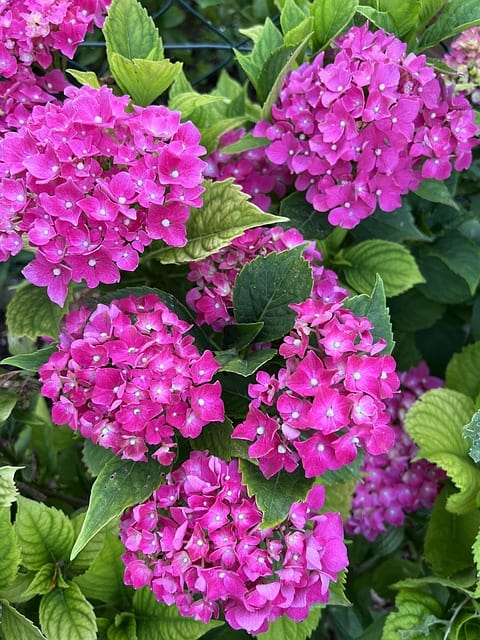
Hydrangeas are a beloved, classic choice for adding a touch of timeless elegance to any outdoor space. With their large, showy blooms and their diverse range of colors, from vibrant pinks and blues to delicate whites and lavenders, these plants are a true showstopper in the garden.
One of the standout features of hydrangeas is their ability to thrive in partial shade, making them an excellent choice for gardeners with areas that receive limited direct sunlight. They prefer well-drained, nutrient-rich soil and regular watering, especially during hot, dry spells, to maintain their lush, healthy appearance.
To encourage continuous blooming, be sure to prune your hydrangeas at the appropriate time of year, typically in late winter or early spring, depending on the specific variety. This will help to stimulate new growth and ensure a bountiful display of flowers throughout the season.
Whether you choose to grow hydrangeas in garden beds, containers, or even as a focal point in a woodland-inspired setting, these iconic plants are sure to add a touch of timeless elegance and charm to your outdoor spaces.
Daffodils
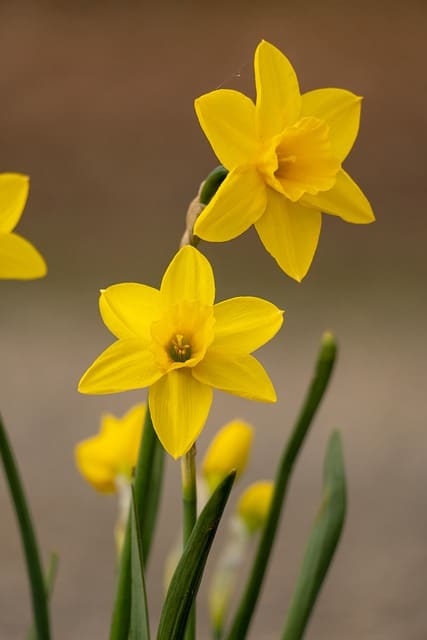
Daffodils are a cheerful, harbinger of spring that bring a burst of color and joy to any outdoor garden. With their sunny, trumpet-shaped blooms and their distinctive, green foliage, these perennial bulbs are a true delight for the senses.
One of the key benefits of growing daffodils is their ability to naturalize, meaning they will readily self-sow and spread over time, creating a lush, carpeted effect in your garden. This makes them an excellent choice for gardeners who want to establish a long-lasting, low-maintenance display of spring color.
When it comes to planting daffodils, they prefer well-drained, nutrient-rich soil and full sun to partial shade. Be sure to plant the bulbs in the fall, before the ground freezes, to ensure a bountiful display of blooms the following spring.
To maintain the health and appearance of your daffodil plants, be sure to leave the foliage in place after the flowers have faded, as this allows the plants to store energy for the next growing season. With their cheerful, iconic blooms and their easy-care nature, daffodils are a must-have for any outdoor garden.
Daylily
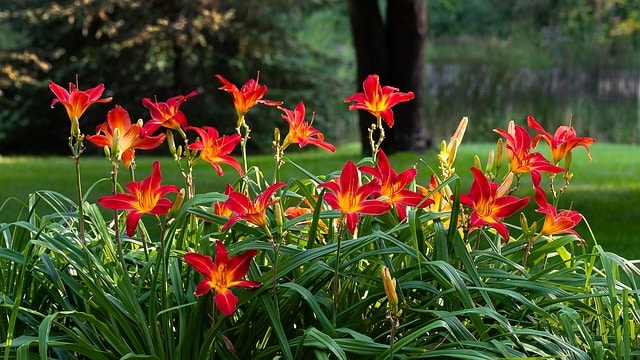
Daylilies are a versatile, low-maintenance perennial that add a burst of color and texture to any outdoor space. With their diverse range of bloom colors, from vibrant oranges and reds to delicate pastels, and their ability to thrive in a variety of growing conditions, these plants are a true workhorse in the garden.
One of the standout features of daylilies is their long blooming season, which can last for several months, depending on the specific variety. This makes them an excellent choice for gardeners who want to create a continuous display of color throughout the growing season.
When it comes to growing daylilies, they prefer full sun and well-drained soil, but they are also relatively tolerant of partial shade and a wide range of soil types. To encourage a bountiful harvest of blooms, be sure to divide the plants every few years, which will help to rejuvenate the clumps and promote new growth.
Whether you choose to plant daylilies in garden beds, borders, or even as a groundcover, their vibrant, eye-catching flowers and their easy-care nature make them a must-have for any outdoor gardener.
Salvia
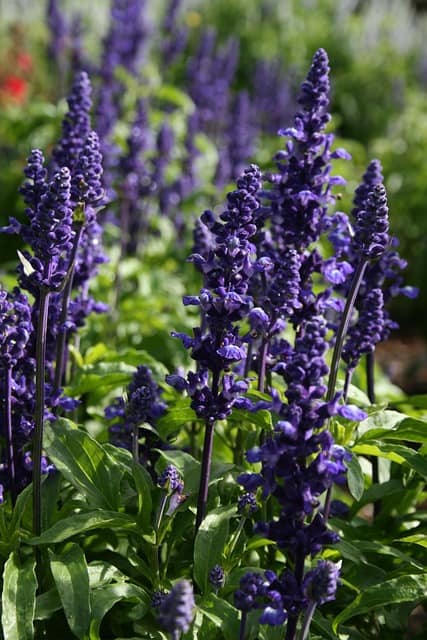
Salvia, also known as sage, is a versatile, aromatic plant that adds a touch of color and fragrance to any outdoor setting. With its diverse range of bloom colors, from the deep, velvety purple of the “Black and Blue” variety to the vibrant, fiery red of the “Lighthouse” type, and its distinctive, savory aroma, this plant is a true delight for the senses.
One of the key benefits of growing salvia is its ability to attract pollinators, such as bees, butterflies, and hummingbirds, to your garden. Its nectar-rich flowers provide an important food source for these vital creatures, making it a crucial component of any wildlife-friendly outdoor space.
When it comes to caring for salvia, it prefers full sun and well-drained soil, but it is also relatively drought-tolerant once established. To maintain its compact, bushy growth habit and
Russian Sage
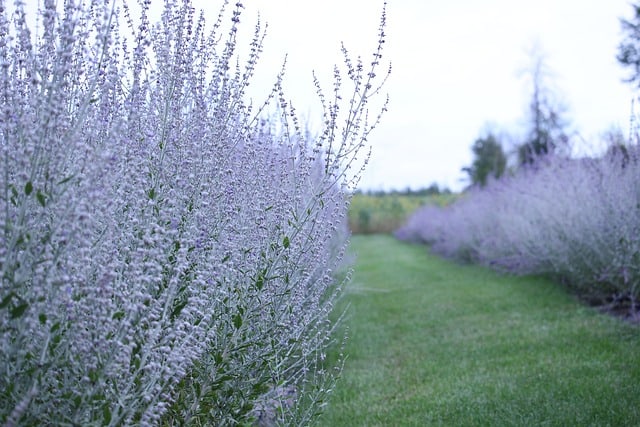
Russian sage is a striking, drought-tolerant perennial that adds a touch of whimsy and elegance to any outdoor space. With its silvery-gray foliage and its vibrant, lavender-blue flower spikes, this plant is a true standout in the garden, creating a captivating contrast against the lush greenery that surrounds it.
One of the key benefits of growing Russian sage is its ability to thrive in hot, dry conditions, making it an excellent choice for gardeners in arid or Mediterranean-style climates. It prefers full sun and well-drained soil, and it requires minimal maintenance, requiring only occasional pruning to maintain its compact, bushy growth habit.
In addition to its visual appeal, Russian sage is also known for its aromatic properties, with its leaves and flowers emitting a subtle, herbal fragrance that can add a soothing, calming element to your outdoor spaces. This makes it a popular choice for planting near seating areas or pathways, where its scent can be enjoyed by passersby.
Whether you choose to incorporate Russian sage into your garden beds, use it as a focal point in a xeriscape-inspired landscape, or plant it in containers on your patio or balcony, this versatile perennial is sure to add a touch of elegance and charm to your outdoor living spaces.
Black Eyed Susan
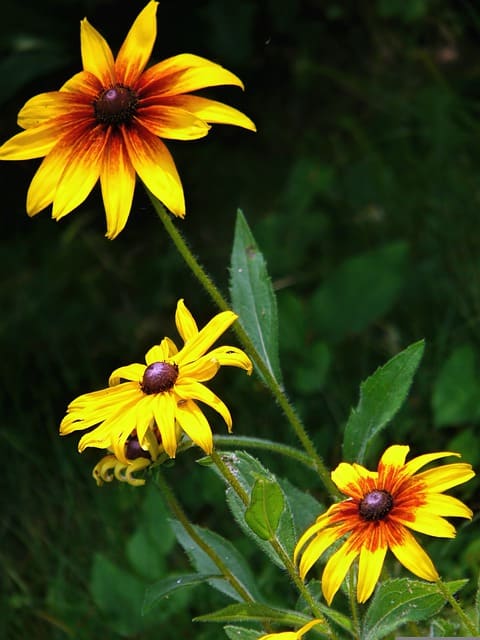
Black-eyed Susans are a cheerful, sun-loving perennial that add a burst of vibrant color to any outdoor garden. With their distinctive, daisy-like flowers and their deep, chocolate-brown centers, these plants are a true standout, creating a captivating contrast against the lush greenery that surrounds them.
One of the key benefits of growing black-eyed Susans is their ability to thrive in a wide range of growing conditions, from full sun to partial shade, and in a variety of soil types, from well-drained to clay-based. This makes them an excellent choice for gardeners with challenging growing environments, as they are relatively low-maintenance and resilient.
In addition to their visual appeal, black-eyed Susans are also known for their long blooming season, which can last from midsummer through the fall, providing a continuous display of color throughout the growing season. To encourage ongoing blooms, be sure to deadhead spent flowers regularly and provide the plants with a balanced, water-soluble fertilizer every few weeks.
Whether you choose to plant black-eyed Susans in garden beds, borders, or even as a groundcover, their vibrant, eye-catching flowers and their easy-care nature make them a must-have for any outdoor gardener.
Catmint
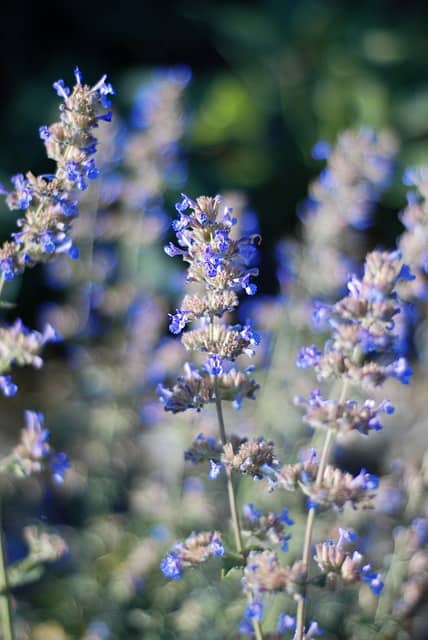
Catmint, also known as catnip, is a versatile, aromatic perennial that adds a touch of whimsy and charm to any outdoor setting. With its silvery-gray foliage and its delicate, lavender-blue flower spikes, this plant is a true delight for the senses, creating a captivating contrast against the lush greenery that surrounds it.
Holly
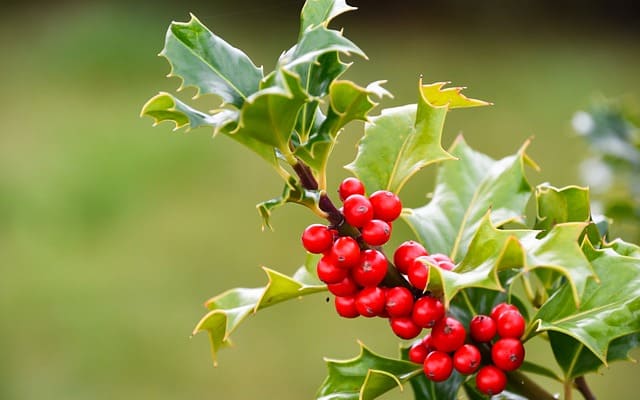
Holly is a classic, evergreen shrub that adds a touch of year-round interest and texture to any outdoor garden. With its glossy, deep green leaves and its vibrant, red berries, this plant is a true standout, creating a captivating contrast against the bare branches of winter or the lush greenery of the growing season.
One of the key benefits of growing holly is its versatility, as it can be used in a variety of landscape applications, from foundation plantings and hedges to specimen plantings and container gardens. It thrives in full sun to partial shade and prefers well-drained, acidic soil, making it an excellent choice for gardeners with a range of growing conditions.
In addition to its visual appeal, holly is also a valuable addition to wildlife-friendly gardens, as its berries provide an important food source for birds and other small creatures during the colder months. To ensure a bountiful harvest of berries, be sure to plant both male and female holly plants, as they require cross-pollination to produce fruit.
Whether you choose to incorporate holly into your landscape as a focal point, a privacy screen, or a low-maintenance groundcover, this iconic evergreen shrub is sure to add a touch of timeless elegance and charm to your outdoor living spaces.
Shasta Daisies
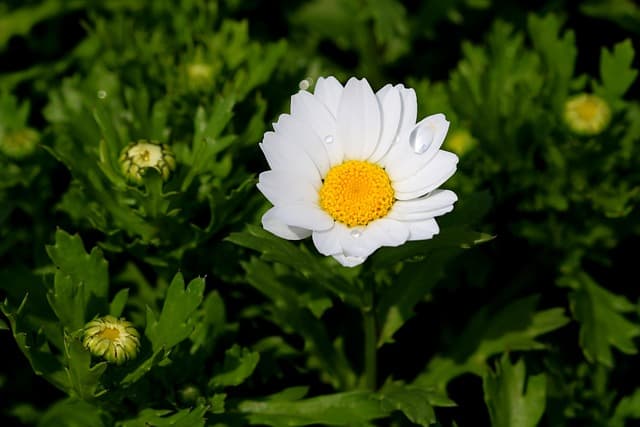
Shasta daisies are a cheerful, sun-loving perennial that add a burst of classic, white-and-yellow blooms to any outdoor garden. With their large, daisy-like flowers and their sturdy, upright growth habit, these plants are a true delight, creating a captivating contrast against the lush greenery that surrounds them.
One of the standout features of Shasta daisies is their long blooming season, which can last from early summer through the fall, providing a continuous display of color throughout the growing season. To encourage ongoing blooms, be sure to deadhead spent flowers regularly and provide the plants with a balanced, water-soluble fertilizer every few weeks.
When it comes to growing Shasta daisies, they prefer full sun and well-drained, nutrient-rich soil, but they are also relatively tolerant of a range of growing conditions, making them an excellent choice for gardeners with challenging environments. Their sturdy, upright growth habit also makes them a popular choice for cutting gardens, as their long-lasting blooms are perfect for fresh or dried floral arrangements.
Whether you choose to plant Shasta daisies in garden beds, borders, or even as a groundcover, their vibrant, eye-catching flowers and their easy-care nature make them a must-have for any outdoor gardener.
Creeping Phlox
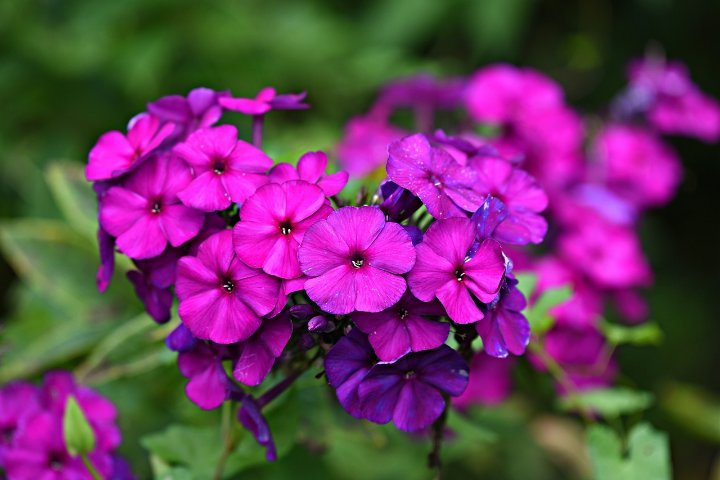
Creeping phlox is a low-growing, mat-forming perennial that adds a touch of vibrant, ground-hugging color to any outdoor setting. With its diverse range of bloom colors, from the delicate, pastel shades of the “Candy Stripe” variety to the bold, jewel-toned hues of the “Emerald Blue” type, this plant is a true delight for the senses, creating a captivating carpet of color that cascades over walls, slopes, and rock gardens.
One of the key benefits of growing creeping phlox is its ability to thrive in a wide range of growing conditions, from full sun to partial shade, and in a variety of soil types, from well-drained to clay-based. This makes it an excellent choice for gardeners with challenging environments, as it is relatively low-maintenance and resilient.
To maintain the health and appearance of your creeping phlox plants, be sure to provide them with regular watering, especially during hot, dry spells, and consider dividing the clumps every few years to encourage new growth and rejuvenate the plants.
Whether you choose to use creeping phlox as a groundcover, a spiller in container plantings, or as a focal point in a rock garden, its vibrant, eye-catching blooms and its easy-care nature make it a must-have for any outdoor gardener.




